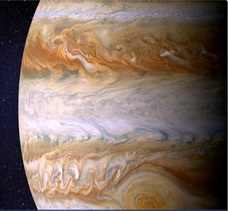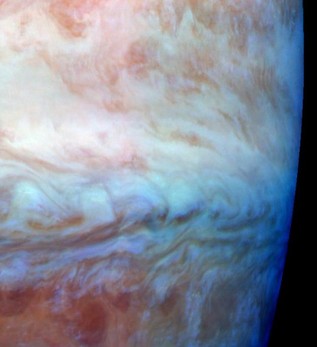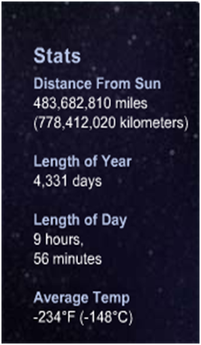Our Solar System
Planet Jupiter (Jovian Gaint)

The most massive planet in our solar system, with four planet-size moons and many smaller satellites, Jupiter forms a kind of miniature solar system. Jupiter resembles a star in composition. In fact, if it had been about eighty times more massive, it would have become a star rather than a planet.
Jupiter's appearance is a tapestry of beautiful colors and atmospheric features. Most visible clouds are composed of ammonia. Water exists deep below and can sometimes be seen through clear spots in the clouds. The planet's "stripes" are dark belts and light zones created by strong east-west winds in Jupiter's upper atmosphere. Within these belts and zones are storm systems that have raged for years. The Great Red Spot, a giant spinning storm, has been observed for more than 300 years.
Jupiter's appearance is a tapestry of beautiful colors and atmospheric features. Most visible clouds are composed of ammonia. Water exists deep below and can sometimes be seen through clear spots in the clouds. The planet's "stripes" are dark belts and light zones created by strong east-west winds in Jupiter's upper atmosphere. Within these belts and zones are storm systems that have raged for years. The Great Red Spot, a giant spinning storm, has been observed for more than 300 years.
Jupiter Atmosphere

The composition of Jupiter's atmosphere is similar to that of the sun—mostly hydrogen and helium. Deep in the atmosphere, the pressure and temperature increase, compressing the hydrogen gas into a liquid. At depths about a third of the way down, the hydrogen becomes metallic and electrically conducting. In this metallic layer, Jupiter's powerful magnetic field is generated by electrical currents driven by Jupiter's fast rotation. At the center, the immense pressure may support a solid core of ice-rock about the size of Earth.
Jupiter's enormous magnetic field is nearly 20,000 times as powerful as Earth's. Trapped within Jupiter's magnetosphere (the area in which magnetic field lines encircle the planet from pole to pole) are swarms of charged particles. Jupiter's rings and moons are embedded in an intense radiation belt of electrons and ions trapped in the magnetic field. The Jovian magnetosphere, composed of these particles and fields, balloons 600,000 to 2 million miles (1 million to 3 million kilometers) toward the sun and tapers into a windsock-shaped tail extending more than 600 million miles (1 billion kilometers) behind Jupiter, as far as Saturn's orbit.
Jupiter's enormous magnetic field is nearly 20,000 times as powerful as Earth's. Trapped within Jupiter's magnetosphere (the area in which magnetic field lines encircle the planet from pole to pole) are swarms of charged particles. Jupiter's rings and moons are embedded in an intense radiation belt of electrons and ions trapped in the magnetic field. The Jovian magnetosphere, composed of these particles and fields, balloons 600,000 to 2 million miles (1 million to 3 million kilometers) toward the sun and tapers into a windsock-shaped tail extending more than 600 million miles (1 billion kilometers) behind Jupiter, as far as Saturn's orbit.

